

 Trolley
Scan(Pty) Ltd
Trolley
Scan(Pty) Ltd
Before the arrival of RFID-radar, readers have been able to read the identity of multiple transponders in a zone at one time, but they have not been able to locate where in the zone the transponders actually are physically.
As the performance of readers and transponders improve, operating ranges increase giving one reader the ability to monitor larger areas meaning location information in addition to the identity information becomes very important.
RFID-radar works with very low cost transponders and relatively cheap reader systems.
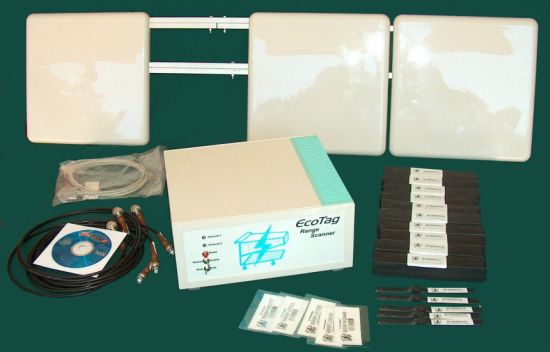
This is a world first base technology, allowing companies involved in its development the ability to deliver very advanced low cost RFID systems for many years.
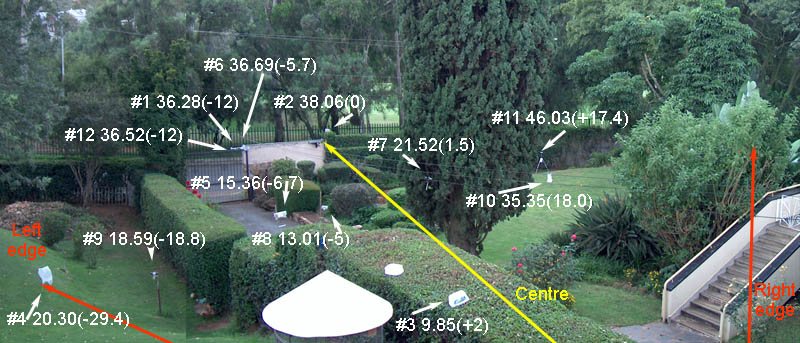
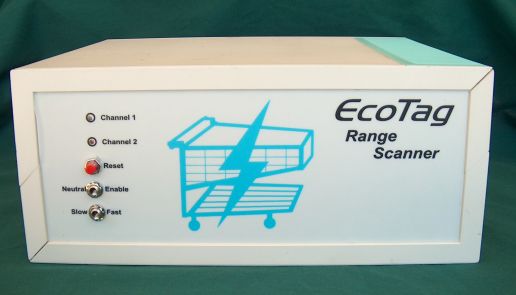
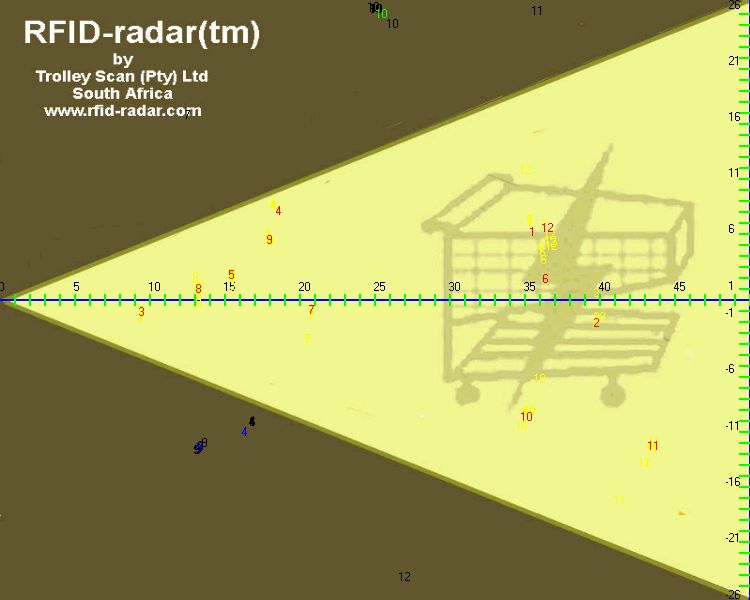
The reader provides an energy field to power up the transponders, and measures the distance the signal travels from the transponder back to the reader. For 2D and 3D applications, two or three receiver channels are included in the reader to allow angle of arrival to be determined at the reader site by comparing the range from each of the reader channels.
The reader contains a fast processor module making up to 10000 range measurements per second to allow the tracking of each of the tags in the zone with update rates at one second intervals.
The reader interfaces to other computer networks via RS232.
The reader has one array of adjacent antennas measuring range from that array to the tags. The array contains one transmit antenna for energising the passive transponders and one antenna for each receiver (2 antennas total for 1D,3 antennas for 2D and four for 3D).
The reader can be set to operate in any frequency range from 860 to 960 Mhz, using 10 kHz of spectrum for the energising signal. Two reader systems can operate within 4 meters of each other. The reader processor consolidates the huge amount of information retrieved by the reader sections. It can report
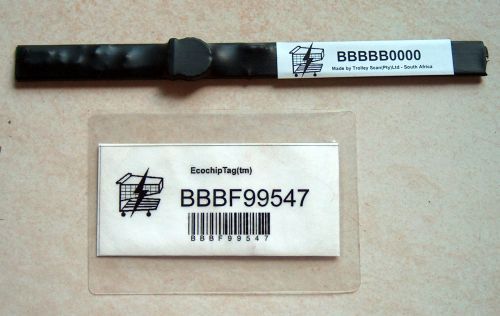
These are passive backscatter Ecotag UHF transponders. They can be packaged in different antenna forms. Operating range depends on the sensitivity of the transponder, with the 5 uW versions operating up to 40 meters, and the 200uW versions working out to 10 meters.
The radar measures the distance the signal travels from the various transponders to the radar antenna. By comparing the range on two receivers, the angle of arrival can be measured and so a direction and range can be shown.
The reader can process about 50 transponders in a zone at a time, at the rate of 10000 range measurements per second,
and can operate up to ranges of 40 meters with suitable transponders.
Only one set of antennas is needed for a full fix with one reader. A third receiver channel can be added to give 3D
coverage rather than 2D coverage (or a second evaluation system fixing the same transponders from a slightly different position and solving mathematically). A major feature of the system, besides its accuracy in measuring the range, is that
the interference generated by this radar for other similar users and for other RF users, such as cell phones, is very low. Many RFIDradar systems
can operate in close proximity without interfering with each other.
Another feature of the radar system is the ability to track moving targets. By measuring the range many times per second of each transponder, the reader can plot the path of a moving object in its field of view.
The reader outputs location and identity information at regular intervals, which can be
displayed on a laptop running a Visual Basic program to show a radar type display.
The radar can also locate and process transponders attached to wood and metal.
When read ranges of RFID systems are small, then location
information is not important as it is always in close
proximity to the reader. As technology improves and the
transponders need less and less power to operate, so the
read range starts increasing, meaning the uncertainty in
the exact location of the transponder increases. This
improved sensitivity transponder technology needs
increased information from the reader to assist in the
speedy location of the transponder and here the technology
detailed in this brochure becomes important.
This invention is the only solution to the RFID-Radar problem
that uses low cost transponders.
The arrival of RFID-radar has stimulated the development of lower powered UHF backscatter transponders to increase
operating range. While conventional RFID readers typically would want maximum read ranges of about ten meters,
RFID-radars ability to report location means that ranges of 40 meters from one reader are being requested.
Trolley Scan are one of the world leaders in UHF RFID
developments and manufacture leading
edge designs which they export currently to 53 countries.
Trolley Scan are now delivering
Light and radio waves travel at the speed of light, namely 300 000 000 meters per second. RFID systems
need to operate in a crowded RF spectrum, where other RFID systems, cell phones, radio stations and
other communication users have to share the available radio spectrum. RFID-radar uses just 10 kilohertz of
bandwidth to operate, meaning it can detect time differences only as small as 0.1 milliseconds, or
0.0001 seconds. In this time the radio wave will travel 30 kilometers, or 30 000 meters or 3 000 000
centimeters Yet the radar is able to determine the range of the transponder based on its received
transmission to an accuracy of a few centimeters, or nearly 1 million times better than its basic
time measuring properties. If we used a conventional military radar approach and wanted to get
centimeter precision, then we would have to measure the time of flight to 0.3pico seconds (.3*10-12)
which would use 300GHz of radio spectrum.
RFID-radar pay for this million times improvement in the timing accuracy of the basic system by taking
a longer time to determine the exact position. As a result it is well suited to a static situations
where transponders are relatively stationary. However developments are in progress to address the
accurate tracking of movement by adapting some of the principles of operation.
We have also now added features that allow movements as small as one millimeter to be measured in static situations.This
allows simultaneous measurements from the reader to up to 50 transponders and can be used to detect movement in structures such as bridges, dam walls, buildings, mine walls and roofs, and other fixed structures that might be stressed by weather, traffic, water pressure, wind etc. Here one lowcost instrument can be
installed to permanently monitor the integrity of structures and send warnings before damage or failure. These measurements are instantaneous.
The angle of arrival measurement is virtually instantaneous and used in conjunction with range
gives a 2D positioning system from a single measuring location.
"RFID-radarTM", "ClaymoreTM" and "Better than a tape measure!TM" are the trademarks of Trolley Scan (Pty) Ltd
The radar algorthm has a practical operating range for measurement of 40 meters with better than 0,5 meter accuracy.
The current 200uW Ecochiptags with the current energiser has a maximum operating range of 10 meters
and the 5uW stick tags have a range of 40 meters. We currently have also developed other forms of transponders
with a maximum range of fifty meters.
As we develop more sensitive transponders so this range can increase.
Specification
Competitive technologies
Functionality
Any Ecochiptag,Ecowoodtag, laundrytag, Ecosportstag, Ecofarmtag or the new 5 microwatt long range tag can be used
with the RFID-radar.
The reader has two receiver channels to measure the range and one energising channel for powering the transponders. The
reader uses a 10kilohertz bandwidth, allowing many readers to operate in close proximity.
Importance of this invention
"The RFID-radar has the performance of a US$1million battlefield radar, but at the price of an RFID reader"
Commercialising
A reader that can generate position information of all
tags in its aperture, and provide updates of their
movement, generates a lot of data.
Specifications of commercial version now being supplied
The specifications of the system are:
Trolley Scan will upgrade any supplied model to any later versions when available at a cost of
the parts, a small service fee and provided the client takes care of freighting and duty costs in returning
systems to South Africa for upgrade.
How does RFID-radar work?
The radar makes two measurements on each signal received from each transponder in its receiving zone -
namely a range measurement and an angle of arrival. It is the ability to measure range with narrow bandwidth
that make this an outstanding unique RFID instrument. The system uses the same transponders that are used
by conventional RFID readers allowing RFID-radars and RFID readers to monitor the same transponder
simultaneously.